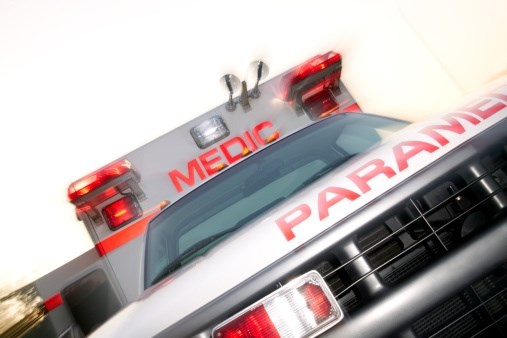Ambulance response times in the region are climbing and have surpassed 14 minutes, according to stats collected by the city.
Locally, there are two ambulances stationed in St. Albert, run by the city but under contract from Alberta Health Services.
Response time has increased since ambulance operations were centralized by AHS, including dispatch.
“Prior to 2009 our ambulances never left the city,” said fire chief Ray Richards. When AHS took over, they made borderless districts.
“We could go to Edmonton, we could go to Spruce Grove … so every time you increase the distance, you increase the response times,” Richards said.
Recent city-tracked quarterly statistics show that for the second quarter of 2014, EMS response time was 14 minutes and 13 seconds.
The city statistics show the response time of the two ambulances stationed in St. Albert, even if they are responding to out-of-town calls.
Richards points out fire response is often a few minutes faster because there are fire stations located strategically throughout the city, and they don’t have to respond to calls outside of St. Albert.
He also noted increasing call volume as a pressure on the system in general. The response time has improved over the past few years, he said, as there have been quarters where EMS response time was more than 14 minutes, but the response times have not been where they were in the years prior to centralization.
The city has targets of a nine-minute service standard for fire and EMS response, and for those services combined. However, they’re not sure what the EMS standard is for AHS.
“We understand that the former health minister had called for a review asking for some kind of standards from Alberta Health Services to state what is the goal but we haven’t heard what those are,” Richards said.
Richards said they’re in ongoing discussions with AHS, including what might trigger the addition of a third ambulance for St. Albert.
That third ambulance is also on Coun. Cathy Heron’s mind. She said the changes to the ambulance system, including dispatch, have been an uphill battle for the city.
While they recently concluded negotiations for a new contract with AHS, something Heron said was a victory for St. Albert, she said the response times are still a concern.
“When you look at the statistics, at 14 minutes, that’s definitely not good enough,” Heron said. “We used to hit nine (minutes).”
She personally knows someone who had to wait 25 minutes for an ambulance in St. Albert after taking a bad fall earlier this year. That day there was no response from the fire department either.
“Who knows what happened that day,” she said, adding a recent decision to upgrade the medical equipment on fire trucks to offer advanced life support service is a positive move.
Heron said the varying statistics can be hard to track, but her priority is how long it takes a St. Albert resident to get an ambulance.
“We’re not done with the advocacy on ambulance. There’s still need for improvement,” she said.
As part of Premier Jim Prentice’s new appointments, Rick Fraser, MLA for Calgary-South East was made legislative secretary for ambulances.
An advance care paramedic himself, he said while ambulance response time is an important measure, it’s not the only thing that should be considered when evaluating emergency medical service. That said, he knows emergency response times do matter to people.
“That’s not lost on us … we’re also facing extreme growth pressures just like the rest of the province and ambulance service is costly … we’ve got to find a way to staff cities and municipalities appropriately that’s still respectful of the taxpayer … that’s always been a juggling act,” Fraser said.
He said ambulance response service standards were historically tied to fire department standards for priority calls and those remain guidelines for the province.
“There is a worldwide standard for that kind of call and it is around nine minutes,” Fraser said.
There’s an opportunity for discussion on how to make sure Alberta has one of the best ambulance systems in the world, he said, and on how paramedics can work with other health care practitioners.




